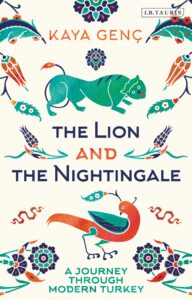
[Bloomsbury; 2019]
Kaya Genç’s The Lion and the Nightingale discusses modern Turkey through the intersecting journeys of different characters and various distinct identities. The individual narratives of the people Genç writes about, or through, compose the book’s story as a whole while situating it within the fluctuating political atmosphere of the country. This anchoring moves the reader through various human experiences — disappointment, failure, representation — with thorough exploration and deep empathy, while also examining potential future projections of a young nation.
I decided to review Genç’s book because when I saw the naming of all four chapters, ‘[A] winter of despair’, ‘[A] spring of hope’, ‘[A] summer of dissent’, and ‘[A] fall of silence’, it reminded me of South Korean filmmaker Kim Ki-duk’s ‘Spring, Summer, Fall, Winter… and Spring’ drama. Turkey’s Justice and Development Party (AKP) went through a similar story as with the symbolism in Ki-duk’s movie. When the party was found, it was a new birth and a new voice for the country, symbolizing spring; and when human rights violations, which was a disgrace for a democratic nation, were solved, and freedom of expression was permitted to religious minorities, Alevites, Kurds, and the LGBTQ+ community, the party reached the youth with a full spirit and motivation and it was respected across the Western capitals. In other words, this was the AKP’s bright summer season, which involved economic prosperity in a concise period. Although, in 2013 the Gezi Park protests transitioned the country into autumn, and the season’s quiescence was noisy. Eventually, after the coup attempt in 2016, the old age winter season of despair for journalists, academics, and art enthusiasts peaked, resulting in a bleak mood. So, The Lion and the Nightingale is first and foremost Kaya Genç’s journey through four different seasons in the last two decades, through which he writes explorations of people from different backgrounds in an effort to understand “What the frustrations of the nation were?”, “[W]hat they did think about the country?”, “How [did] they live their hours?”, and how they find their authentic voice? As such, The Lion and the Nightingale merges memoir, interview and historical reporting.
Genç, who is also the author of Under the Shadow: Rage and Revolution in Modern Turkey (2016), explains in the introduction to his most recent book how he decided to stay in the country whereas most of his author, journalist and intellectual friends — in other words the ‘Nightingales’, a synonym he uses throughout the book — decided to leave for Europe, the United Kingdom (UK) or the United States (US). He frames his choice to stay as a “moral responsibility”, feeling an obligation to not only write about the country but from it. For Genç, the ‘Nightingale’ represents “the song, the literature and the romance” of his masterful chronicle of Turkey, whereas the Lion stands for “strength, the military, and power”. Consequently, Genç examines the conflicts and interests of both camps.
Freedom of expression and human rights are two of the core discussions within the book. Genç explores how there is a gap between people’s views and their articulation in public. He takes the reader through various lived historical and political experiences, describing how since the Gezi Park protests in 2013, the country has become less tolerant and diverse when it comes to different identities and political views and that how under the powerful President of Turkey, Recep Tayyip Erdoğan, Turkey has been through different times. According to Genç, 2013 was a turning point for Erdoğan when the AKP no longer considered itself an ally of ‘Turkish liberals’. However, I believe that this change started after 2010 when Erdoğan followed a pro-Palestinian course and encountered Israeli politics, first at the World Economy Forum when Erdoğan stormed out after clashing with Israeli president in 2009, and then, one year later, when the Mavi Marmara aid flotilla was stopped and attacked by the Israeli Defence Force in international waters. Yet, Genç’s approach is vital because it symbolizes the change of the AKP’s policies locally. Gezi Park protests exemplify the first major uprising against the ruling party. Opposition voices could create an online public sphere, tweet in English, and were heard across the globe, whereas the AKP could not manage the narrative both within mainstream and across digital media. After the protests, Erdoğan mobilized loyal business people to be involved in the media world and it was the beginning of an increasing dominance of the pro-government media. However, Genç explains that the real change in Turkish politics happened after the July 2016 coup attempt. Critical journalists were jailed and media outlets, affiliated with the coup plotters, were shut down or transformed. Subsequently, 80 per cent of the media became pro-government which lead to an increase in censorship — another critical point that continues to prevent diverse voices from being heard. Genç highlights that there are specific columnists who are dominating the media and newspaper reporting more than the journalists who are on the ground and living the experience. As a result, becoming a journalist is no longer a tempting profession for young writers and media students. Whereas conversely, some foreign journalists have had to leave Turkey in pursuit of critical coverage of the ruling party, meaning Turkey has become somewhat of a beacon of safety for journalists and Islamists from the Middle East who sought to escape from oppressive regimes.
The precarity of the media, arts and culture scene in Turkey is described comprehensively in chapter four. One of the personalities featured here is a filmmaker and contemporary artist Kutluğ Ataman, great-grandson of an Ottoman landlord, who was picked by The Observer as the ‘best and brightest artist’ of the year in 2003. Ataman has a novel story, moving first from Istanbul to Los Angeles to study at the University of California after being jailed for his political activities when he was seventeen. In the book, Genç explains how Ataman — who is currently working on a new film project that discusses the postmodern coup in 1997 by portraying a friendship between a transgender person and a woman who wore a headscarf — played a vital role during the Gezi Park protests, having met with President Erdoğan in order to meddle between two opposing camps. Ataman’s support for the LGBTQ+ community and his role as an intermediary during the protests led him to a unique position in Turkey’s political circumstances. However, protesters misunderstood Ataman’s sedative attitude and he was ignored by Istanbul’s many artists, curators and art professionals; so he decided to escape from Istanbul’s disturbing atmosphere to Erzincan’s serenity, where he built an architecturally award-winning house. Genç discusses other fellow Istanbulites like Vasıf Kortun, an intellectual and founder of Salt, a contemporary art institution in Turkey, and Defne Koryürek, founder of Slow Food Turkey and food activist, and how they too decided to leave the city in 2016 and moved to Ayvalık, a seaside town on the Northwestern Aegean coast.
The rising number of trained and qualified people deciding to leave Turkey, in other words, ‘brain drain’, is an essential topic of Kaya Genç’s study. He explains this reality by highlighting that “the best-educated minds of the Republic found themselves lost”. The Young Turks of the early twentieth-century Ottoman era are an example the author discusses in his ‘[A] summer of dissent’ chapter. Similar to today, he underlines how the educated class in the Ottoman era had to live abroad “because of their criticism of the Turkish state”. Yeditepe University and MAK Consultancy’s latest research in August 2020 reflects Genç’s critical analysis, suggesting that 76 per cent of young people prefer to live abroad for better options. It characterizes how despite Erdoğan’s ‘pious generation’ agenda, which he developed in particular by building Imam Hatip and private schools, where both a religious and positivist curriculum are taught, or by supporting foundations for youth, new electorates are not hopeful for their future in the country. This uncertainty, a word regularly used by the author in his work, of the younger generation, is both a loss for the ruling government and an opportunity for the opposition, and newly emerging parties to convince the digital natives to get their support. Genç explores how after the postmodern coup in 1997 enfeebled religious conservatives left the country because of unequal access to education; and how in the post-coup attempt era in 2016, more and more opposition voices decided to flee the country. Within the same framework, Genç discusses how since the AKP came to power, the meaning of ‘Turkish elites’ has changed as religious conservative families followed the same protocol of sending their children to Western institutions to get a better education. But as a result, the children of AKP supporters, the generation Z in particular, are embracing a different mindset compared to their parents, searching for the meaning of faith in particular. It is also important to note the role of popular culture in this, and how that has a considerable influence through digital communication, which should not be underestimated in a country like Turkey.
What gives this book substantial weight is that Kaya Genç expresses his experiences through a literary art of political storytelling. Yet, the primary critical outcome of The Lion and the Nightingale is the essential need for freedom in the country. Genç underlines that “Turkey’s past was oppressive. I could see that the present moment was no different.” Looking from a broader perspective, Genç quotes Turkish poet Ahmet Hamdi Tanpınar to elaborate on instability: “Turkey does not allow its children to care for anything besides its own problems”. Only when young people can share their political views on social media without any hesitation, or intellectuals choose to stay in the country believing they will have equal if not better opportunities there, or that journalists can report on reality without any fear will the toxic political atmosphere be able to gradually vanish and the economy hopefully recover.
Taner Dogan is the author of Communication Strategies in Turkey: Erdoğan, the AKP and Political Messaging (I.B.Tauris Bloomsbury 2021). He holds a PhD from City, University of London, and is researching political communication, journalism, digital culture, populism, and Islamism in Turkey and the Middle East. He tweets @tnrdogan1.
This post may contain affiliate links.







